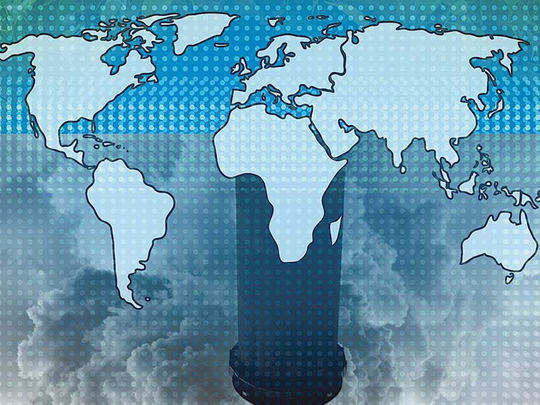
Climate change is constantly near the top of the global agenda with the G7 countries championing the cause for carbon emission reductions. The Paris Agreement which was universally adopted in December 2015 has seen many members of the United Nations Framework Convention on Climate Change (UNFCCC) take measures to implement initiatives, under what are now more transparent and clearer guidelines of governance.
Emerging markets also appear to be following in the footsteps of their counterparts, such as BRIC giants India and China, both undergoing a period of growth and transformation, while facing similar challenges of overpopulation and pollution as a result.
So what does this mean for a hydrocarbon-driven economy? For those Arab countries whose main source of revenue comes from oil, an alternative source may just be as welcome. This comes at a time when oil prices are relatively lower — from highs of $110 a barrel to circa $50, since prices began their decline in 2014. While the reduction in oil pricing bodes well for end users, it comes at the detriment to economic sustainability and the environment as consumption levels increase.
Pre-empting which, many regional oil producing governments have already announced changes to their fiscal plan involving diversification strategies addressing the development of industries, manufacturing, travel and tourism. With the introduction of “Green Bonds”, clean energy may soon see renewed interest in this type of funding as a means of investment and social impact.
Globally the sector has witnessed unprecedented growth over the last few years with 2016 being its most prolific yet — a 92 per cent increase in bond issuance since the previous year. More surprisingly, China was one of its biggest contributors, issuing the largest single green bond for $4.3 billion from the Bank of Communications last year.
While natural resources are generally under conservation, sunlight is one of the greatest assets in the Middle East, and in abundance, making solar energy an attractive proposition. The UAE, Saudi Arabia, Jordan and Morocco are already taking initiatives embracing solar power.
In fact, solar energy is not only environment-friendly but touted to soon be the cheapest power form in the world in less than a decade, pricing lower than coal and other fossil fuels. The reason behind its changing affordability owes to new revelations in manufacturing technology and subsidies stemming from government initiatives and the deployment of green bonds and research programmes.
Advanced technology is perhaps one of the single biggest motivators affecting the supply chain, enabling solar plants to now produce higher volumes (kilo watts) at lower cost margins, making solar energy an even more attractive power source. Sunbelt countries also largely benefit from cost-cutting, coupled with the implementation of auction-based tender management, as observed from the record low bids received by Abu Dhabi Water and Electricity Authority’s procurement arm on its Sweihan solar project last year.
Furthermore, Dubai recently launched the Clean Energy Strategy 2050, which aims to make Dubai a global centre of clean energy and green economy. It includes a Dh100 billion investment in Green Fund and Dh50 billion in the second phase of Solar Park by 2030.
Green bonds are specific financial instruments which are similar to traditional bonds, except that the purpose or “use of proceeds” are earmarked for environment-friendly projects and green initiatives which may include the development of brownfield sites, renewable energy or clean water projects. They are risk-weighted and credit rated much in the usual way, based on the creditworthiness of the issuer, and are generally listed, traded and regulated in the same way as other bonds in the international bond markets.
Initial demand market was largely driven by environmentally and socially responsible investors and has continued to grow, developing into an asset class in its own right. As a result, discussion about a green sukuk has emerged, following Islamic finance principles, in that, they are structured in the same manner as a traditional sukuk observing Sharia.
The focus on social and environmental responsibility is perhaps most clearly noticeable in the Islamic finance market, especially following the issuance of a RM100 million Sustainable and Responsible Investment Sukuk by Khazanah Nasional Berhad (Malaysia’s state-owned sovereign wealth fund), and two successful sukuk issuances by the International Finance Facility for Immunisation Company.
KNB used the proceeds from the issuance to fund schools to improve the accessibility of quality education in Malaysia, while the proceeds from the latter issuance were donated to the Gavi Vaccine Alliance for immunisation programmes to strengthen health systems.
Therefore, it seems that it is only a matter of time before a green sukuk issuance is issued, especially given that entities such as the Islamic Development Bank and the Dubai Electricity and Water Authority have launched numerous climate-related initiatives, including a $180 million pilot project to fund clean energy by the IDB and a commitment by DEWA to increase its solar power target by 5 per cent to 15 per cent of its total capacity.
The IDB indicated it may issue green Sukuk bonds at the Conference of Parties in Paris in 2015, and the Clean Energy Business Council has been in discussions with the Dubai Supreme Council of Energy about the issuance of green sukuk, which could be propelled by the announcement of the Dubai Clean Energy Strategy 2050.
In light of which, we believe that there are significant opportunities to build on the increased focus on environmental responsibility in the Islamic finance market, notably in relation to green infrastructure, allowing investors to hedge against climate change in their investment portfolio; and diversify their portfolio with a promising asset class.
The writer is Partner at White & Case.












